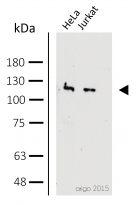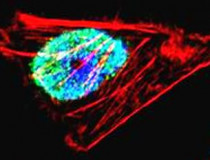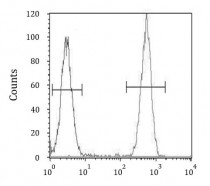ARG54933
anti-TERT antibody
anti-TERT antibody for ELISA,Flow cytometry,ICC/IF,Western blot and Human
Cancer antibody; Developmental Biology antibody; Gene Regulation antibody
Overview
| Product Description | Rabbit Polyclonal antibody recognizes TERT |
|---|---|
| Tested Reactivity | Hu |
| Tested Application | ELISA, FACS, ICC/IF, WB |
| Host | Rabbit |
| Clonality | Polyclonal |
| Isotype | IgG |
| Target Name | TERT |
| Antigen Species | Human |
| Immunogen | KLH-conjugated synthetic peptide corresponding to aa. 627-656 (Center) of Human TERT. |
| Conjugation | Un-conjugated |
| Alternate Names | DKCA2; HEST2; Telomerase catalytic subunit; Telomerase reverse transcriptase; EC 2.7.7.49; DKCB4; hTRT; PFBMFT1; Telomerase-associated protein 2; TP2; EST2; hEST2; TRT; CMM9; TCS1 |
Application Instructions
| Application Suggestion |
|
||||||||||
|---|---|---|---|---|---|---|---|---|---|---|---|
| Application Note | * The dilutions indicate recommended starting dilutions and the optimal dilutions or concentrations should be determined by the scientist. |
Properties
| Form | Liquid |
|---|---|
| Purification | This antibody is prepared by Saturated Ammonium Sulfate (SAS) precipitation followed by dialysis against PBS. |
| Buffer | PBS and 0.09% (W/V) Sodium azide |
| Preservative | 0.09% (W/V) Sodium azide |
| Storage Instruction | For continuous use, store undiluted antibody at 2-8°C for up to a week. For long-term storage, aliquot and store at -20°C or below. Storage in frost free freezers is not recommended. Avoid repeated freeze/thaw cycles. Suggest spin the vial prior to opening. The antibody solution should be gently mixed before use. |
| Note | For laboratory research only, not for drug, diagnostic or other use. |
Bioinformation
| Database Links | |
|---|---|
| Gene Symbol | TERT |
| Gene Full Name | telomerase reverse transcriptase |
| Background | Telomerase is a ribonucleoprotein polymerase that maintains telomere ends by addition of the telomere repeat TTAGGG. The enzyme consists of a protein component with reverse transcriptase activity, encoded by this gene, and an RNA component which serves as a template for the telomere repeat. Telomerase expression plays a role in cellular senescence, as it is normally repressed in postnatal somatic cells resulting in progressive shortening of telomeres. Deregulation of telomerase expression in somatic cells may be involved in oncogenesis. Studies in mouse suggest that telomerase also participates in chromosomal repair, since de novo synthesis of telomere repeats may occur at double-stranded breaks. Alternatively spliced variants encoding different isoforms of telomerase reverse transcriptase have been identified; the full-length sequence of some variants has not been determined. Alternative splicing at this locus is thought to be one mechanism of regulation of telomerase activity. [provided by RefSeq, Jul 2008] |
| Function | Telomerase is a ribonucleoprotein enzyme essential for the replication of chromosome termini in most eukaryotes. Active in progenitor and cancer cells. Inactive, or very low activity, in normal somatic cells. Catalytic component of the teleromerase holoenzyme complex whose main activity is the elongation of telomeres by acting as a reverse transcriptase that adds simple sequence repeats to chromosome ends by copying a template sequence within the RNA component of the enzyme. Catalyzes the RNA-dependent extension of 3'-chromosomal termini with the 6-nucleotide telomeric repeat unit, 5'-TTAGGG-3'. The catalytic cycle involves primer binding, primer extension and release of product once the template boundary has been reached or nascent product translocation followed by further extension. More active on substrates containing 2 or 3 telomeric repeats. Telomerase activity is regulated by a number of factors including telomerase complex-associated proteins, chaperones and polypeptide modifiers. Modulates Wnt signaling. Plays important roles in aging and antiapoptosis. [UniProt] |
| Cellular Localization | Chromosome, Cytoplasm, Nucleus, Telomere |
| Highlight | Related products: TERT antibodies; Anti-Rabbit IgG secondary antibodies; |
| Research Area | Cancer antibody; Developmental Biology antibody; Gene Regulation antibody |
| Calculated MW | 127 kDa |
| PTM | Phosphorylation at Tyr-707 under oxidative stress leads to translocation of TERT to the cytoplasm and reduces its antiapoptotic activity. Dephosphorylated by SHP2/PTPN11 leading to nuclear retention. Phosphorylation at Ser-227 by the AKT pathway promotes nuclear location. Phosphorylation at the G2/M phase at Ser-457 by DYRK2 promotes ubiquitination by the EDVP complex and degradation. Ubiquitinated by the EDVP complex, a E3 ligase complex following phosphorylation at Ser-457 by DYRK2. Ubiquitinated leads to proteasomal degradation. In case of infection by HIV-1, the EDVP complex is hijacked by HIV-1 via interaction between HIV-1 Vpr and DCAF1/VPRBP, leading to ubiquitination and degradation. |
Images (3) Click the Picture to Zoom In
-
ARG54933 anti-TERT antibody WB image
Western blot: 30 µg of HeLa and Jurkat cell line lysates stained with ARG54933 anti-TERT antibody at 1:500 dilution.
-
ARG54933 anti-TERT antibody ICC/IF image
Immunofluorescence: HeLa cells were fixed with 4% PFA (20 min), permeabilized with Triton X-100 (0.1%, 10 min), then stained with ARG54933 anti-TERT antibody (green) at 1:25 dilution, 1 h at 37°C. Cytoplasmic actin was counterstained with Alexa Fluor® 555 (red) conjugated Phalloidin (7 units/ml, 1 h at 37°C). DAPI (blue) for nuclear staining.
-
ARG54933 anti-TERT antibody FACS image
Flow Cytometry: HeLa cells stained with ARG54933 anti-TERT antibody (right histogram) or without primary antibody control (left histogram), followed by incubation with FITC labelled secondary antibody.










